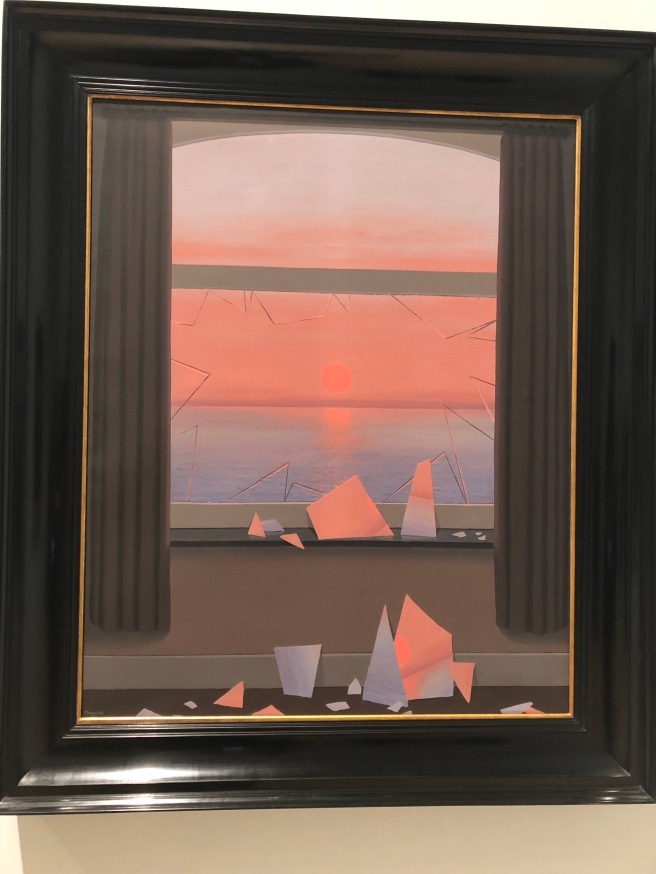I’ve always been fascinated by the strange and subversive, so when I began to learn about Surrealism in art school, I was hooked. I pored over Dali paintings, spent a semester studying Frida Kahlo and fell in love with the beautifully executed, yet off-kilter work of Rene Magritte.
Rene Magritte (1898-1967) was a Belgian surrealist painter who explored the concept of the untrustworthiness of images. His work constantly pushes you to think, what am I really looking at? “The Treachery of Images,” one of Magritte’s most famous pieces, depicts a pipe, with the words “This is not a pipe.” The point here is that it’s not a pipe, it’s the image of a pipe.

Magritte Exhibit at the SFMoMA (May 19 – October 28, 2018)
Recently, I was lucky enough to attend the San Francisco Museum of Modern Art’s Rene Magritte exhibit, which contained 77 of the surrealist master’s original paintings and drawings. I also opted for the audio tour, which contained commentary from the museum’s curators, people who were close to Magritte, and even famous artists like Jeff Koons.
The following is an amalgam of direct quotes and paraphrasing from the exhibit and audio tour, along with my own thoughts, reflections and commentary.
Mid- and Post-WWII Work
Magritte’s Sunlit Surrealism and Vache Periods
With the onslaught of World War II and the German occupation of Belgium, Magritte adopted an understandably bleak outlook, and we see a shocking shift in his painting styles during this time, a break from his prewar surrealist work.

On first glance, this piece appears simple, cheerful and even optimistic, but when you consider the context, it’s 1943 and Magritte’s home country is being destroyed by the Germans, the bright colors and cheerful tone quickly begin to feel perverse. When positioned in these dark historical times, this piece could even be describes as haunting, creepy, or altogether fucked up.
During Magritte’s “Sunlit Surrealism” period, he renounces the violence and pessimism of his earlier work. He tends toward romantic sunset hues with an overtly impressionistic pastiche, but the subject matter is still quite disturbing.

Those who knew Magritte would quickly understand that this slapstick humor is actually a caricature of the French king Louis Philippe I.
Magritte’s Vache Period, which lasted from 1947 to 1948, was marked by a certain nastiness. His portrayals were sloppy and at times even ugly with crude, cloying color palettes and wild, imprecise brush strokes.

In “The Cripple” we see one of Magritte’s first explorations with pipes as subject matter and points of subversion as there are entirely too many of them. Perhaps this again is commentary on the untrustworthiness of images?


Another vache painting, “Seasickness” portrays another hasty, crude scene in which a slice of ham lies on a plaid blazer, both cooking in the hallucinatory sun’s rays. The simple question here is “why?” and suffice to say, the simple answer is, as with many of his works, “that’s Magritte.”
Can We Really Be So Sure?
Another common theme in Magritte’s work was the use of windows. Paintings using windows as frames provide a certain sense of safety to the viewer; we’ve all looked out of windows before, we know how they work and what to expect. But with Magritte’s pieces, such as with “Le Monde Des Images” below, can we really be so sure? What is real and what is painting?

Hypertrophy

Again revisiting the concept of the untrustworthiness of images, we see “The Listening Room,” which, like many of Magritte’s pieces, fills the viewer with questions. Is this a normal size apple in a tiny room, or is it a monstrous apple in a normal size room. And perhaps more importantly, what are we to do about this apple? The image persists and unsettles.

In “Personal Values” we see a host of everyday objects placed in an everyday setting but in a way that’s entirely wrong to us. Magritte, who’s been called “A master of the ordinary” strips these normally comforting objects from their practical functions, rendering them enigmatic. The cracks in the ceiling, albeit a small detail, serve to reinforce the instability of the image.
These “hypertrophied” objects endanger the rooms they are in just like hypertrophied organs endanger their bodies.
The Bowler Men
Magritte painted a series of paintings with men in bowler hats. One theory as to why was that he enjoyed detective novels. He purposely depicted them from behind or with their faces covered to shred them from any hint of personality, pushing the idea of the bourgeois everyman.

It is thought that “The Son of Man,” one of Magritte’s most famous images, began as a self portrait. Theorists also believe that Magritte placed the apple in front of the man’s face because he could be a post-war German, striving for anonymity. Also, take a closer look at the right sleeve. Notice how it’s actually backward? This is yet another time we see that something’s not quite right.
One thought on “Art Review of Rene Magritte: Something’s Not Quite Right”